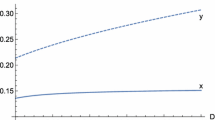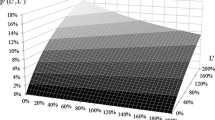Abstract
In this paper, we show that Tobin's q has a significant predictive power in explaining valuation consequences of major corporate policy variables. Our empirical results reveal that, depending upon whether a firm is overinvesting or underinvesting, financial markets respond quite differently to its capital structure, dividend payout, financial slack, and R & D decisions. Overall, the empirical results suggest that both high debt ratios and greater payouts are favorably viewed by the market when firms are overinvesting. For firms with growth opportunities, however, large debt is unfavorably viewed by the market. In addition, financial slack and R & D expenditures are favorably received by the market for growth firms but not for overinvesting firms.
Similar content being viewed by others
References
Ben-Zion, U., “The Investment Aspects of Non-productive Expenditures: An Empirical Test.” Journal of Economics and Business 30, 224–229, (1978).
Brainard, W.C. and J. Tobin, “Econometric Models: Their Problems and Usefulness—Pitfalls in Financial Model Building.” American Economic Review 58, 99–122, (1968).
Chan, S.H., J.D. Martin, and J.W. Kensinger, “Corporate Research and Development Expenditures and Share Value.” Journal of Financial Economics 26, 255–276, (1990).
Chung, K.H. and S.W. Pruitt, “A Simple Approximation of Tobin's q.” Financial Management 23, 70–74, (1994).
Connolly, R.A. and M. Hirschey, “R & D, Market Structure and Profits: A Value-based Approach.” Review of Economics and Statistics 66, 682–686, (1984).
Easterbrook, F.H., “Two Agency Costs Explanations of Dividends.” American Economic Review 74, 650–659, (1984).
Erickson, G. and R. Jacobson, “Gaining Comparative Advantage through Discretionary Expenditures: The Returns to R & D and Advertising.” Management Science 38, 1264–1279, (1992).
Fuller, W.A. and G.E. Battese, “Estimation of Linear Models with Crossed-error Structure.” Journal of Econometrics 2, 67–78, (1974).
Griliches, Z., “Market Value, R & D, and Patents.” Economic Letters 7, 183–187, (1981).
Hall, B.H., “The Manufacturing Sector Master File Documentation: 1959–1987.” Mimeo (University of California at Berkeley, Berkeley, CA, and National Bureau of Economic Research, Cambridge, MA), 1990.
Hall, B.H., “The Stock Market's Valuation of R & D Investment during the 1980's.” American Economic Review 83, 259–264, (1993).
Hayashi, F., “Tobin's Marginal q and Average q: A Neoclassical Interpretation.” Econometrica 50, 215–224, (1982).
Hayashi, F. and T. Inoue, “The Relation between Firm Growth and q with Multiple Capital Goods: Theory and Evidence from Panel Data on Japanese Firms.” Econometrica 59, 731–753, (1991).
Hirschey, M., “Intangible Capital Aspects of Advertising and R & D Expenditures.” Journal of Industrial Economics 30, 375–390, (1982).
Jaffe, A.B., “Technological Opportunity and Spillovers of R & D: Evidence from Firms' Patents, Profits, and Market Value.” American Economic Review 76, 984–1001, (1986).
Jensen, M., “Agency Costs of Free Cash Flow, Corporate Finance, and Takeovers.” American Economic Review 76, 323–329, (1986).
Jose, M.L., L.M. Nichols, and J. Stevens, “Contributions of Diversification, Promotion, and R & D to the Value of Multiproduct Firms: A Tobin's q Approach.” Financial Management 15, 33–42, (1986).
Jung, K., Y. Kim, and R. Stulz, “Timing, Investment Opportunities, Managerial Discretion, and the Security Issue Decision.” Journal of Financial Economics 42, 159–185, (1996).
Lang, L. and R.H. Litzenberger, “Dividend Announcements: Cash Flow Signalling vs. Free Cash Flow Hypothesis?” Journal of Financial Economics 24, 181–191, (1989).
Lang, L., E. Ofek, and R. Stulz, “Leverage, Investment, and Firm Growth.” Journal of Financial Economics 40, 3–29, (1996).
Lee, W.H., “The Effect of Exchange Offers and Stock Swaps on Equity Risk and Shareholders' Wealth: A Signalling Model Approach.” Ph.D. dissertation (UCLA, Los Angeles, CA), 1987.
Lindenberg, E.B. and S.A. Ross, “Tobin's q Ratio and Industrial Organization.” Journal of Business 54, 1–32, (1981).
Malkiel, B., G.M. Von Furstenberg, and H.S. Watson, “Expectations, Tobin's q, and Industry Investment.” Journal of Finance 34, 549–654, (1979).
Masulis, R.W., “The Effects of Capital Structure Change on Security Prices: A Study of Exchange Offers.” Journal of Financial Economics 8, 139–177, (1980).
Mood, A., F. Graybill, and D. Boes, Introduction to the Theory of Statistics. Tokyo: McGraw-Hill Kogakusha, Ltd., 1974.
Murphy, K., “Corporate Performance and Managerial Remuneration: An Empirical Analysis.” Journal of Accounting and Economics 7, 11–42, (1985).
Myers, S., “The Capital Structure Puzzle.” Journal of Finance 39, 575–592, (1984).
Myers, S. and N. Majluf, “Corporate Financing and Investment Decisions When Firms Have Information That Investors Do Not Have.” Journal of Financial Economics 13, 187–222, (1984).
Pakes, A., “On Patents, R & D, and Stock Market Rate of Return.” Journal of Political Economy 93, 390–409, (1985).
Pilotte, E., “Growth Opportunities and the Stock Price Response to New Financing.” Journal of Business 65, 371–4, (1992).
Rozeff, M., “Growth, Beta and Agency Costs as Determinants of Dividend Payout Ratios.” Journal of Financial Research 5, 249–259, (1982).
Salinger, F.M., “Tobin's q, Unionization, and the Concentration-Profits Relationship.” Rand Journal of Economics 15, 159–170, (1984).
Schaller, H., “A Re-examination of the q Theory of Investment using U.S. Firm Data.” Journal of Applied Econometrics 5, 309–325, (1990).
Summers, L.H., “Taxation and Corporate Investment: A q-Theory Approach.” Brookings Papers on Economic Activity 1, 67–127, (1981).
Sundaram, A.K., T. John, and K. John, “An Empirical Analysis of Strategic Competition and Firm Values: The Case of R & D Competition.” Journal of Financial Economics 40, 459–486, (1996).
Tobin, J., “Monetary Policies and the Economy: The Transmission Mechanism.” Southern Economic Journal 44, 421–431, (1978).
White, H., “A Heteroskedasticity-Consistent Covariance Matrix Estimator and a Direct Test for Heteroskedasticity.” Econometrica 48, 817–838, (1980).
Author information
Authors and Affiliations
Rights and permissions
About this article
Cite this article
Chung, K.H., Wright, P. Corporate Policy and Market Value: A q-Theory Approach. Review of Quantitative Finance and Accounting 11, 293–310 (1998). https://doi.org/10.1023/A:1008385900638
Issue Date:
DOI: https://doi.org/10.1023/A:1008385900638




